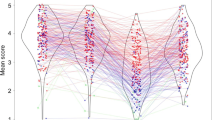Abstract
Two experiments replicated the Spence and Holland (1962) study which yielded positive support for a psychoanalytic theory of subliminal perception. In Experiment I groups were exposed to stimuli whose quality ranged from slightly above to well below the forced-choice detection threshold. In Experiment II groups were exposed to stimuli whose quality was at three different levels below the forced-choice detection threshold. Only one of the 10 experimental groups gave support to the Spence and Holland theory that subliminal stimuli affect retention of words by communicating with unconscious associations on the basis of meaning. An attempt to replicate this finding with a second group proved unsuccessful. Although some support may have been obtained for the contention that stimuli which are slightly above the forced-choice detection threshold affect retention of words on the basis of structural similarities between stimulus and words, the findings as a whole do not support the Spence and Holland psychoanalytic theory of unconscious perception.
Similar content being viewed by others
References
BERNSTEIN & ERIKSEN, C. W. 1965. Effects of subliminal prompting on paired-associates learning. Journal of Experimental Research in Personality, 1, 33–38.
BLACKWELL, H. R. 1952. The influence of data collection procedures upon psychophysical measurement of two sensory functions. Journal of Experimental Psychology, 44, 306–315.
BLUM, G. S. 1954. An experimental reunion of psychoanalytic theory with perceptual vigilance and defense. Journal of Abnormal and Social Psychology, 49, 94–98.
BRESSLER, J. 1931. Illusion in the case of subliminal visual stimulation. Journal of General Psychology, 5, 244–250.
GOLDIAMOND, I. 1958. Indicators of perception: I. Subliminal perception, subception, unconscious perception: An analysis in terms of psychophysical indicator methodology. Psychological Bulletin, 55, 373–411.
JUNG, J. 1966. Restricting effects of awareness: Serial position bias in Spence’s study. Journal of Personality and Social Psychology, 3, 124–128.
SILVERMAN, L. H., & SILVERMAN, D. K. 1964. A clinical-experimental approach to the study of subliminal stimulation: The effects of a drive-related stimulus upon Rorschach responses. Journal of Abnormal and Social Psychology, 69, 158–172.
SPENCE, D. P., & HOLLAND, B. 1962. The restricting effects of awareness: A paradox and an explanation. Journal of Abnormal and Social Psychology, 64, 163–174.
WORRELL L., & WORRELL, J. 1966. An experimental and theoretical note on conscious and preconscious influences on recall. Journal of Personality and Social Psychology, 3, 119–123.
Author information
Authors and Affiliations
Rights and permissions
About this article
Cite this article
Jennings, L.B., George, S.G. The Spence Holland Theory of Subliminal Perception: A Reexamination. Psychol Rec 20, 495–504 (1970). https://doi.org/10.1007/BF03393971
Published:
Issue Date:
DOI: https://doi.org/10.1007/BF03393971




